Banana Classification Using Sanger Sequencing of the Ribosomal DNA Internal Transcribed Spacer (ITS) Region
Abstract
1. Introduction
2. Results
2.1. ITS Sequencing of 62 Banana Accessions
2.2. Classification of Different Banana Subgroups Using the 420-bp Region of ITS
2.3. Identification of Hybrid Bananas Using the 420-bp Region of ITS
3. Discussion
4. Material and Methods
4.1. Materials
4.2. Rapid Extraction of Banana Genomic DNA
4.3. PCR, Sequencing, and Analysis
Supplementary Materials
Author Contributions
Funding
Data Availability Statement
Acknowledgments
Conflicts of Interest
References
- Simmonds, N.W. The evolution of the bananas. Longmans Green 1962, 170, 101–131. [Google Scholar]
- Simmonds, N.W.; Shepherd, K. The taxonomy and origins of the cultivated bananas. J. Linn. Soc. Lond. Bot. 1955, 55, 302–312. [Google Scholar] [CrossRef]
- Biswas, M.K.; Yi, G. Genes and markers: Application in banana crop improvement. In Banana: Genomics and Transgenic Approaches for Genetic Improvement; Mohandas, S., Ravishankar, K., Eds.; Springer Press: Singapore, 2016; pp. 35–50. [Google Scholar]
- Inta, W.; Traiperm, P.; Ruchisansakun, S.; Janssens, S.; Viboonjun, U.; Swangpol, S. Evolution and classification of Musaceae based on male floral morphology. Plants 2023, 12, 1602. [Google Scholar] [CrossRef] [PubMed]
- Brisibe, E.; Ubi, G.; Ekanem, N. Descriptive and multivariate analyses of morphotaxonomic and yield-related traits in inflorescence dichotomous cultivars of Musa species (AAB genome). Genet. Resour. Crop Evolut. 2021, 68, 3357–3372. [Google Scholar] [CrossRef]
- Sawant, G.; Dalvi, V.; Ambavane, A.; Santosh, G. Evaluation of qualitative traits in banana (Musa spp.). Genomes 2018, 10, 548–551. [Google Scholar]
- Pillay, M. The genetic homogeneity of Uganda’s east African Highland bananas (Mutika/Lujugira) does not match the extensive morphological variation identified in this subgroup. Int. J. Plant Biol. 2024, 15, 267–280. [Google Scholar] [CrossRef]
- Kaemmer, D.; Afza, R.; Weising, K.; Kahl, G.; Novak, F. Oligonucleotide and amplification fingerprinting of wild species and cultivars of banana (Musa spp.). Nat. Biotechnol. 1992, 10, 1030–1035. [Google Scholar] [CrossRef] [PubMed]
- Risterucci, A.-M.; Hippolyte, I.; Perrier, X.; Xia, L.; Caig, V.; Evers, M.; Huttner, E.; Kilian, A. Development and assessment of diversity arrays technology for high-throughput DNA analyses in Musa. Theor. Appl. Genet. 2009, 119, 1093–1103. [Google Scholar] [CrossRef] [PubMed]
- Hinge, V.R.; Shaikh, I.M.; Chavhan, R.L.; Deshmukh, A.S.; Shelake, R.M.; Ghuge, S.A.; Dethe, A.M.; Suprasanna, P.; Kadam, U.S. Assessment of genetic diversity and volatile content of commercially grown banana (Musa spp.) cultivars. Sci. Rep. 2022, 12, 7979. [Google Scholar] [CrossRef]
- Ravishankar, K.; Vidhya, L.; Cyriac, A.; Rekha, A.; Goel, R.; Sharma, N.K. Development of SSR markers based on a survey of genomic sequences and their molecular analysis in banana (Musa spp.). J. Hortic. Sci. Biotech. 2012, 87, 84–88. [Google Scholar] [CrossRef]
- Rotchanapreeda, T.; Wongniam, S.; Swangpol, S.; Chareonsap, P.; Sukkaewmanee, N.; Somana, J. Development of SSR markers from Musa balbisiana for genetic diversity analysis among Thai bananas. Plant Syst. Evol. 2016, 302, 739–761. [Google Scholar] [CrossRef]
- Backiyarani, S.; Chandrasekar, A.; Uma, S.; Saraswathi, M.S. MusatransSSRDB (a transcriptome derived SSR database)—An advanced tool for banana improvement. J. Biosci. 2019, 44, 4. [Google Scholar] [CrossRef]
- Ahmad, F.; Megia, R.; Poerba, Y.S. Genetic diversity of Musa balbisiana Colla in Indonesia based on AFLP marker. HAYATI J. Biosci. 2014, 21, 39–47. [Google Scholar] [CrossRef][Green Version]
- de Jesus, O.N.; Silva Sde, O.; Amorim, E.P.; Ferreira, C.F.; de Campos, J.M.; Silva Gde, G.; Figueira, A. Genetic diversity and population structure of Musa accessions in ex situ conservation. BMC Plant Biol. 2013, 13, 41. [Google Scholar] [CrossRef] [PubMed]
- Mertens, A.; Bawin, Y.; Vanden Abeele, S.; Kallow, S.; Toan Vu, D.; Thi Le, L.; Dang Vu, T.; Swennen, R.; Vandelook, F.; Panis, B.; et al. Genetic diversity and structure of Musa balbisiana populations in Vietnam and its implications for the conservation of banana crop wild relatives. PLoS ONE 2021, 16, e0253255. [Google Scholar] [CrossRef] [PubMed]
- Sardos, J.; Christelová, P.; Čížková, J.; Paofa, J.; Sachter-Smith, G.L.; Janssens, S.B.; Rauka, G.; Ruas, M.; Daniells, J.W.; Doležel, J.; et al. Collection of new diversity of wild and cultivated bananas (Musa spp.) in the Autonomous Region of Bougainville, Papua New Guinea. Genet. Resour. Crop Evolut. 2018, 65, 2267–2286. [Google Scholar] [CrossRef]
- Ganal, M.W.; Altmann, T.; Roder, M.S. SNP identification in crop plants. Curr. Opin. Plant Biol. 2009, 12, 211–217. [Google Scholar] [CrossRef] [PubMed]
- Thomson, M.J. High-throughput SNP genotyping to accelerate crop improvement. Plant Breed. Biotechnol. 2014, 2, 195–212. [Google Scholar] [CrossRef]
- Park, Y.J.; Lee, J.K.; Kim, N.S. Simple sequence repeat polymorphisms (SSRPs) for evaluation of molecular diversity and germplasm classification of minor crops. Molecules 2009, 14, 4546–4569. [Google Scholar] [CrossRef]
- Sardos, J.; Rouard, M.; Hueber, Y.; Cenci, A.; Hyma, K.E.; van den Houwe, I.; Hribova, E.; Courtois, B.; Roux, N. A genome-wide association study on the seedless phenotype in banana (Musa spp.) reveals the potential of a selected panel to detect candidate genes in a vegetatively propagated crop. PLoS ONE 2016, 11, e0154448. [Google Scholar] [CrossRef]
- Cenci, A.; Sardos, J.; Hueber, Y.; Martin, G.; Breton, C.; Roux, N.; Swennen, R.; Carpentier, S.; Rouard, M. Unraveling the complex story of intergenomic recombination in ABB allotriploid bananas. Ann. Bot. 2021, 127, 7–20. [Google Scholar] [CrossRef]
- Till, B.; Jankowicz-Cieslak, J.; Sagi, L.; Huynh, O.; Utsushi, H.; Swennen, R.; Terauchi, R.; Mba, C. Discovery of nucleotide polymorphisms in the Musa gene pool by EcoTILLING. TAG Theor. Appl. Genet. 2010, 121, 1381–1389. [Google Scholar] [CrossRef] [PubMed]
- Martin, G.; Cottin, A.; Baurens, F.C.; Labadie, K.; Hervouet, C.; Salmon, F.; Paulo-de-la-Reberdiere, N.; Van den Houwe, I.; Sardos, J.; Aury, J.M.; et al. Interspecific introgression patterns reveal the origins of worldwide cultivated bananas in New Guinea. Plant J. 2023, 113, 802–818. [Google Scholar] [CrossRef]
- Martin, G.; Cardi, C.; Sarah, G.; Ricci, S.; Jenny, C.; Fondi, E.; Perrier, X.; Glaszmann, J.C.; D’Hont, A.; Yahiaoui, N. Genome ancestry mosaics reveal multiple and cryptic contributors to cultivated banana. Plant J. 2020, 102, 1008–1025. [Google Scholar] [CrossRef]
- Gardoce, R.R.; Manohar, A.N.C.; Mendoza, J.S.; Tejano, M.S.; Nocum, J.D.L.; Lachica, G.C.; Gueco, L.S.; Cueva, F.M.D.; Lantican, D.V. A novel SNP panel developed for targeted genotyping-by-sequencing (GBS) reveals genetic diversity and population structure of Musa spp. germplasm collection. Mol. Genet. Genom. 2023, 298, 857–869. [Google Scholar] [CrossRef] [PubMed]
- Boyer, S.L.; Flechtner, V.R.; Johansen, J.R. Is the 16S-23S rRNA internal transcribed spacer region a good tool for use in molecular systematics and population genetics? A case study in cyanobacteria. Mol. Biol. Evol. 2001, 18, 1057–1069. [Google Scholar] [CrossRef] [PubMed]
- Alvarez, I.; Wendel, J.F. Ribosomal ITS sequences and plant phylogenetic inference. Mol. Phylogenet. Evolut. 2003, 29, 417–434. [Google Scholar] [CrossRef]
- Harnelly, E.; Kusuma, H.I.; Thomy, Z.; Samingan, S. Internal transcribed spacer (ITS) gene as an accurate DNA barcode for identification of macroscopic fungus in Aceh. Biodiversitas J. Biol. Divers. 2022, 23, 2369–2378. [Google Scholar] [CrossRef]
- Nehal, N.; Choudhary, B.; Nagpure, A.; Gupta, R.K. DNA barcoding: A modern age tool for detection of adulteration in food. Crit. Rev. Biotechnol. 2021, 41, 767–791. [Google Scholar] [CrossRef]
- Nwakanma, D.C.; Pillay, M.; Okoli, B.E.; Tenkouano, A. PCR-RFLP of the ribosomal DNA internal transcribed spacers (ITS) provides markers for the A and B genomes in Musa L. Theor. Appl. Genet. 2003, 108, 154–159. [Google Scholar] [CrossRef]
- Dita, M.A.; Waalwijk, C.; Buddenhagen, I.W.; Souza, M.T., Jr.; Kema, G.H.J. A molecular diagnostic for tropical race 4 of the banana fusarium wilt pathogen. Plant Pathol. 2010, 59, 348–357. [Google Scholar] [CrossRef]
- Teo, C.H.; Tan, S.H.; Ho, C.L.; Faridah, Q.Z.; Othman, Y.R.; Heslop-Harrison, J.S.; Kalendar, R.; Schulman, A.H. Genomic constitution and classification using retrotransposon-based markers in the orphan crop banana. J. Plant Biol. 2005, 48, 96–105. [Google Scholar] [CrossRef]
- Nair, A.S.; Teo, C.H.; Schwarzacher, T.; Harrison, P.H. Genome classification of banana cultivars from South India using IRAP markers. Euphytica 2005, 144, 285–290. [Google Scholar] [CrossRef]
- Li, L.F.; Hakkinen, M.; Yuan, Y.M.; Hao, G.; Ge, X.J. Molecular phylogeny and systematics of the banana family (Musaceae) inferred from multiple nuclear and chloroplast DNA fragments, with a special reference to the genus Musa. Mol. Phylogenet. Evolut. 2010, 57, 1–10. [Google Scholar] [CrossRef]
- Liu, A.; Kress, W.; Li, D.-Z. Phylogenetic analyses of the banana family (Musaceae) based on nuclear ribosomal (ITS) and chloroplast (trnL-F) evidence. Taxon 2010, 59, 20–28. [Google Scholar] [CrossRef]
- Hribova, E.; Cizkova, J.; Christelova, P.; Taudien, S.; de Langhe, E.; Dolezel, J. The ITS1-5.8S-ITS2 sequence region in the Musaceae: Structure, diversity and use in molecular phylogeny. PLoS ONE 2011, 6, e17863. [Google Scholar] [CrossRef] [PubMed]
- De Langhe, E.; Vrydaghs, L.; De Maret, P.; Perrier, X.; Denham, T. Why bananas matter: An introduction to the history of banana domestication. Ethnobot. Res. Appl. 2009, 7, 165–177. [Google Scholar] [CrossRef]
- Perrier, X.; De Langhe, E.; Donohue, M.; Lentfer, C.; Vrydaghs, L.; Bakry, F.; Carreel, F.; Hippolyte, I.; Horry, J.P.; Jenny, C.; et al. Multidisciplinary perspectives on banana (Musa spp.) domestication. Proc. Natl. Acad. Sci. USA 2011, 108, 11311–11318. [Google Scholar] [CrossRef]
- Morán, J.F. Improvement of cavendish banana cultivars through conventional breeding. Acta Hortic. 2013, 986, 205–208. [Google Scholar] [CrossRef]
- You, Q.; Yang, X.; Peng, Z.; Xu, L.; Wang, J. Development and applications of a high throughput genotyping tool for polyploid crops: Single nucleotide polymorphism (SNP) array. Front. Plant Sci. 2018, 9, 104. [Google Scholar] [CrossRef]
- Hebert, P.D.; Ratnasingham, S.; deWaard, J.R. Barcoding animal life: Cytochrome c oxidase subunit 1 divergences among closely related species. Proc. Biol. Sci. 2003, 270 (Suppl. 1), S96–S99. [Google Scholar] [CrossRef] [PubMed]
- Christelova, P.; Valarik, M.; Hribova, E.; Van den Houwe, I.; Channeliere, S.; Roux, N.; Dolezel, J. A platform for efficient genotyping in Musa using microsatellite markers. AoB Plants 2011, 2011, plr024. [Google Scholar] [CrossRef] [PubMed]
- Saraswathi, M.S.; Uma, S.; Vadivel, E.; Durai, P.; Siva, S.A.; Rajagopal, G.; Sathiamoorthy, S. Diversity analysis in Indian cooking bananas (Musa, ABB) through morphotaxonomic and molecular characterization. Acta Hortic. 2011, 897, 123–131. [Google Scholar] [CrossRef]
- Christelová, P.; Langhe, E.; Hribova, E.; Cizkova, J.; Sardos, J.; Hušáková, M.; Houwe, I.; Sutanto, A.; Kepler, A.; Swennen, R.; et al. Molecular and cytological characterization of the global Musa germplasm collection provides insights into the treasure of banana diversity. Biodivers. Conserv. 2017, 26, 801–824. [Google Scholar] [CrossRef]
- Taheri, S.; Lee Abdullah, T.; Yusop, M.R.; Hanafi, M.M.; Sahebi, M.; Azizi, P.; Shamshiri, R.R. Mining and development of novel SSR markers using next generation sequencing (NGS) data in plants. Molecules 2018, 23, 399. [Google Scholar] [CrossRef] [PubMed]
- Dellaporta, S.L.; Wood, J.; Hicks, J.B. A plant DNA minipreparation: Version II. Plant Mol. Biol. Rep. 1983, 1, 19–21. [Google Scholar] [CrossRef]
- Hsiao, C.; Chatterton, N.; Asay, K.; Jensen, K. Phylogenetic relationships of 10 grass species: An assessment of phylogenetic utility of the internal transcribed spacer region in nuclear ribosomal DNA in monocots. Genome 1994, 37, 112–120. [Google Scholar] [CrossRef] [PubMed]
- White, T.J.; Bruns, T.; Lee, S.; Taylor, J. Amplification and direct sequencing of fungal ribosomal RNA genes for phylogenetics. In PCR Protocols; Academic Press: Pittsburgh, PA, USA, 1989; Volume 38, pp. 315–322. [Google Scholar]
- Syombua, E.D.; Zhang, Z.; Tripathi, J.N.; Ntui, V.O.; Kang, M.; George, O.O.; Edward, N.K.; Wang, K.; Yang, B.; Tripathi, L. A CRISPR/Cas9-based genome-editing system for yam (Dioscorea spp.). Plant Biotechnol. J. 2021, 19, 645–647. [Google Scholar] [CrossRef]
- Hou, B.H.; Tsai, Y.H.; Chiang, M.H.; Tsao, S.M.; Huang, S.H.; Chao, C.P.; Chen, H.M. Cultivar-specific markers, mutations, and chimerisim of Cavendish banana somaclonal variants resistant to Fusarium oxysporum f. sp. cubense tropical race. BMC Genom. 2022, 23, 470. [Google Scholar] [CrossRef]
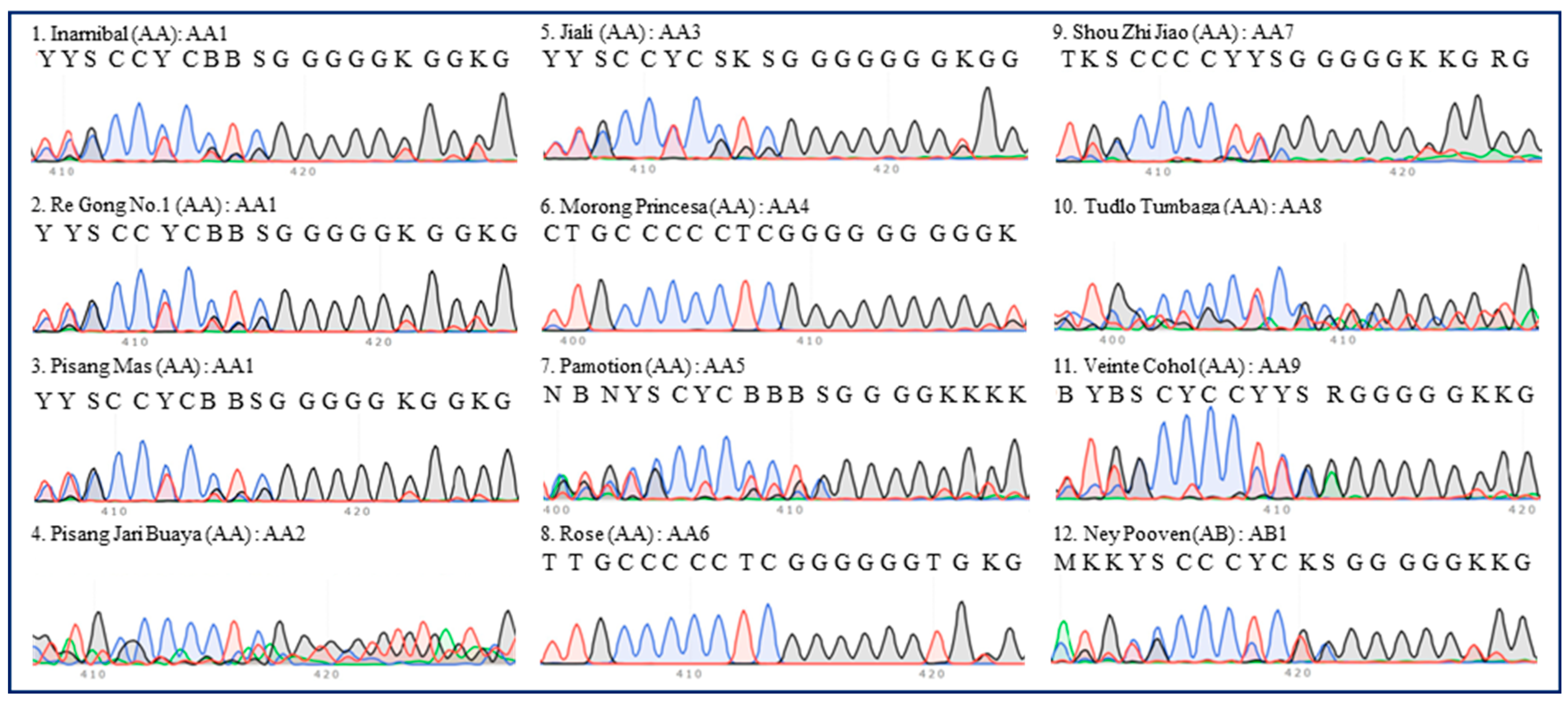
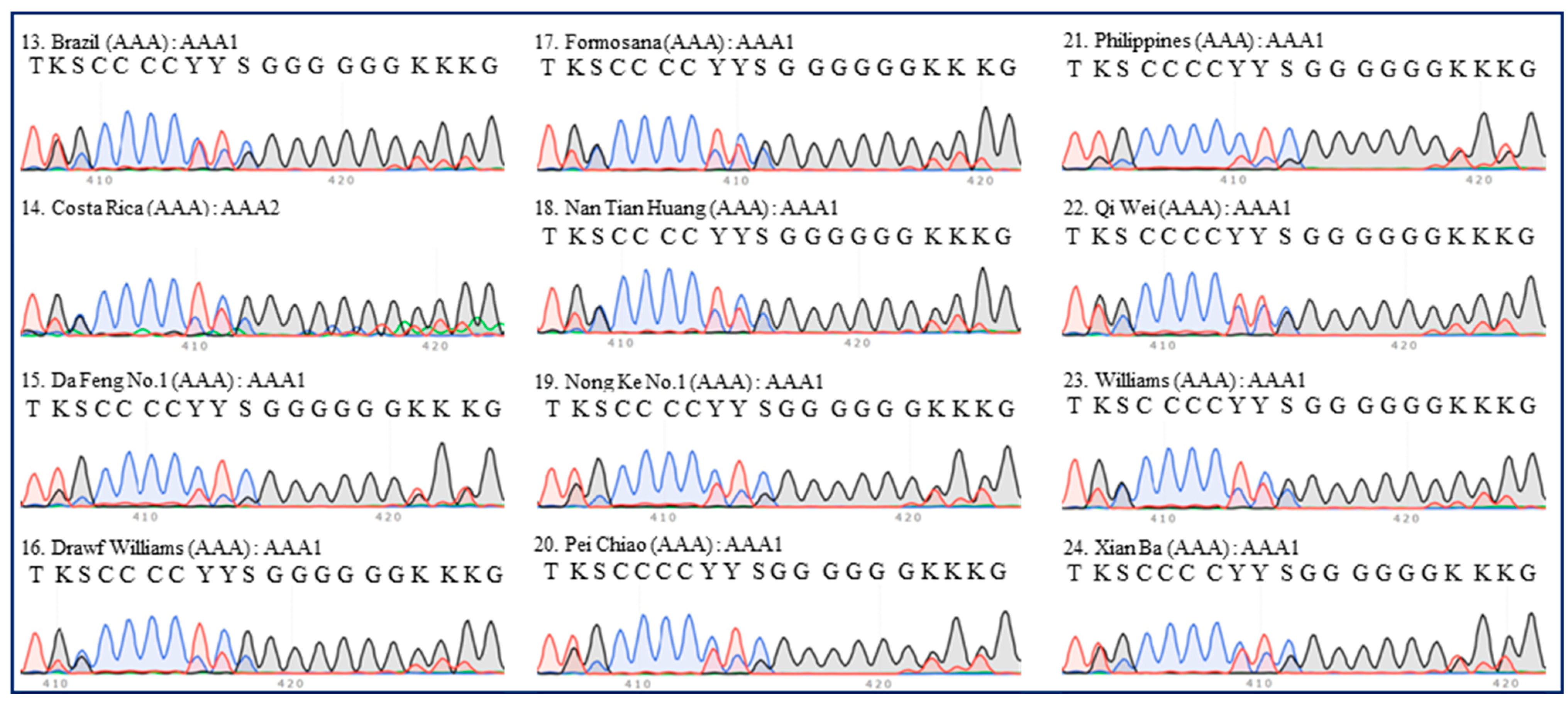
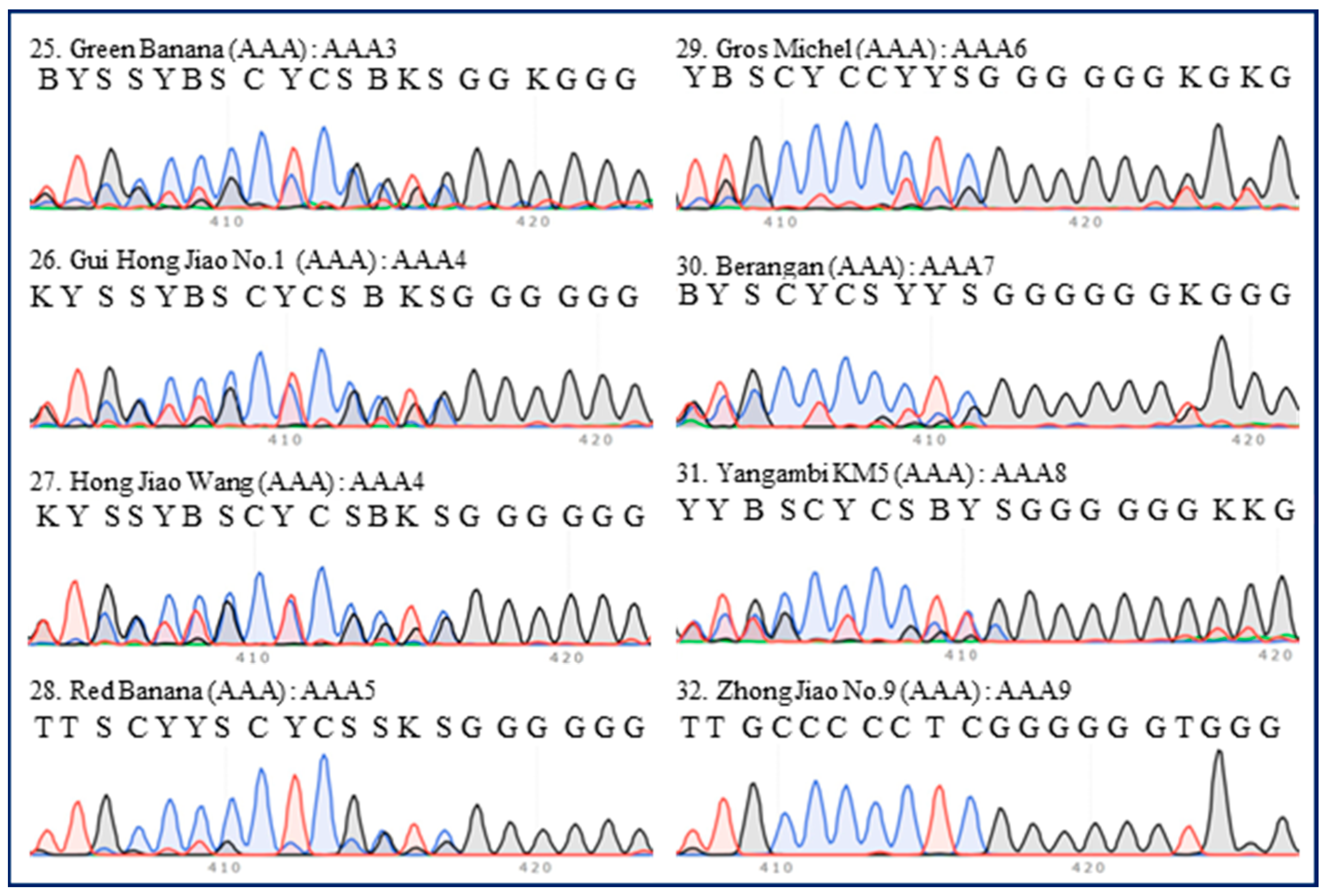
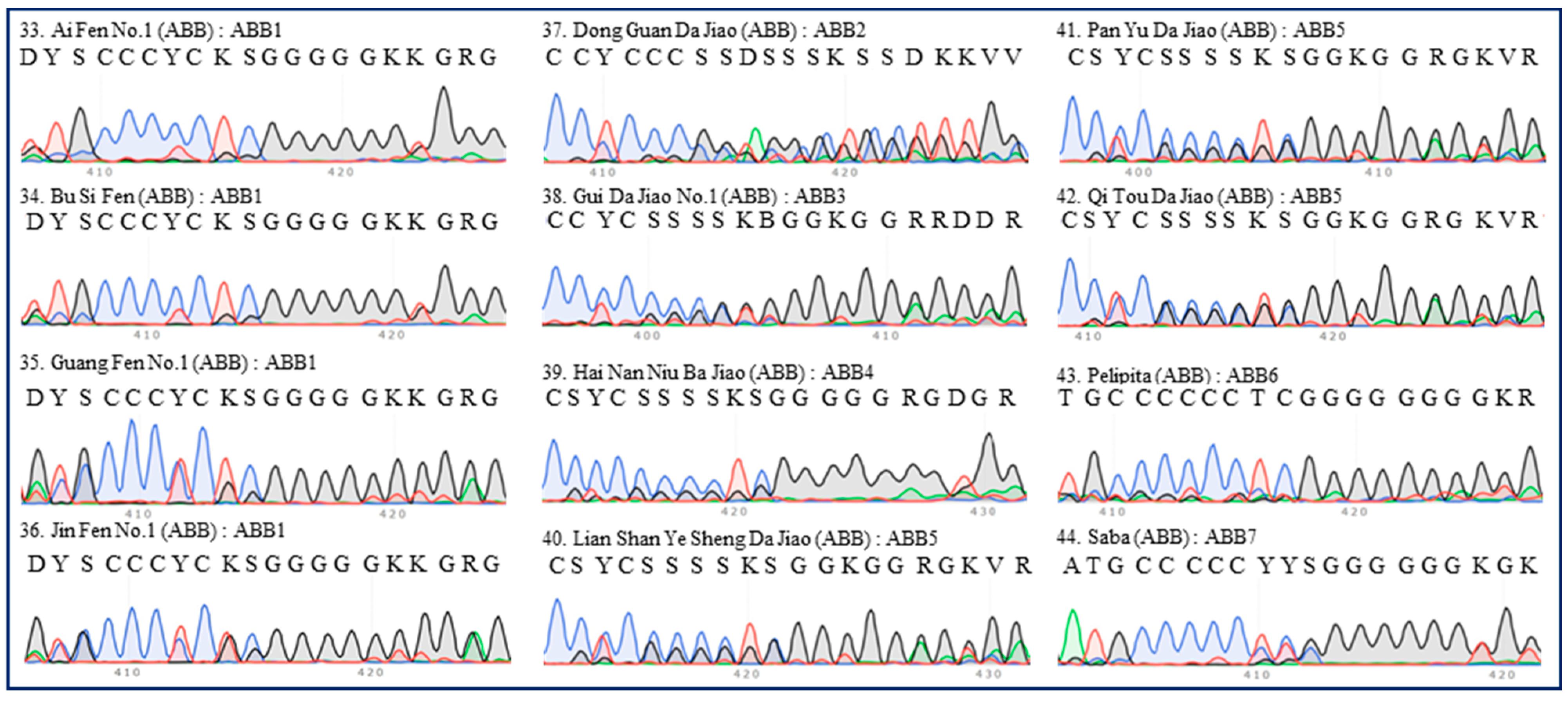
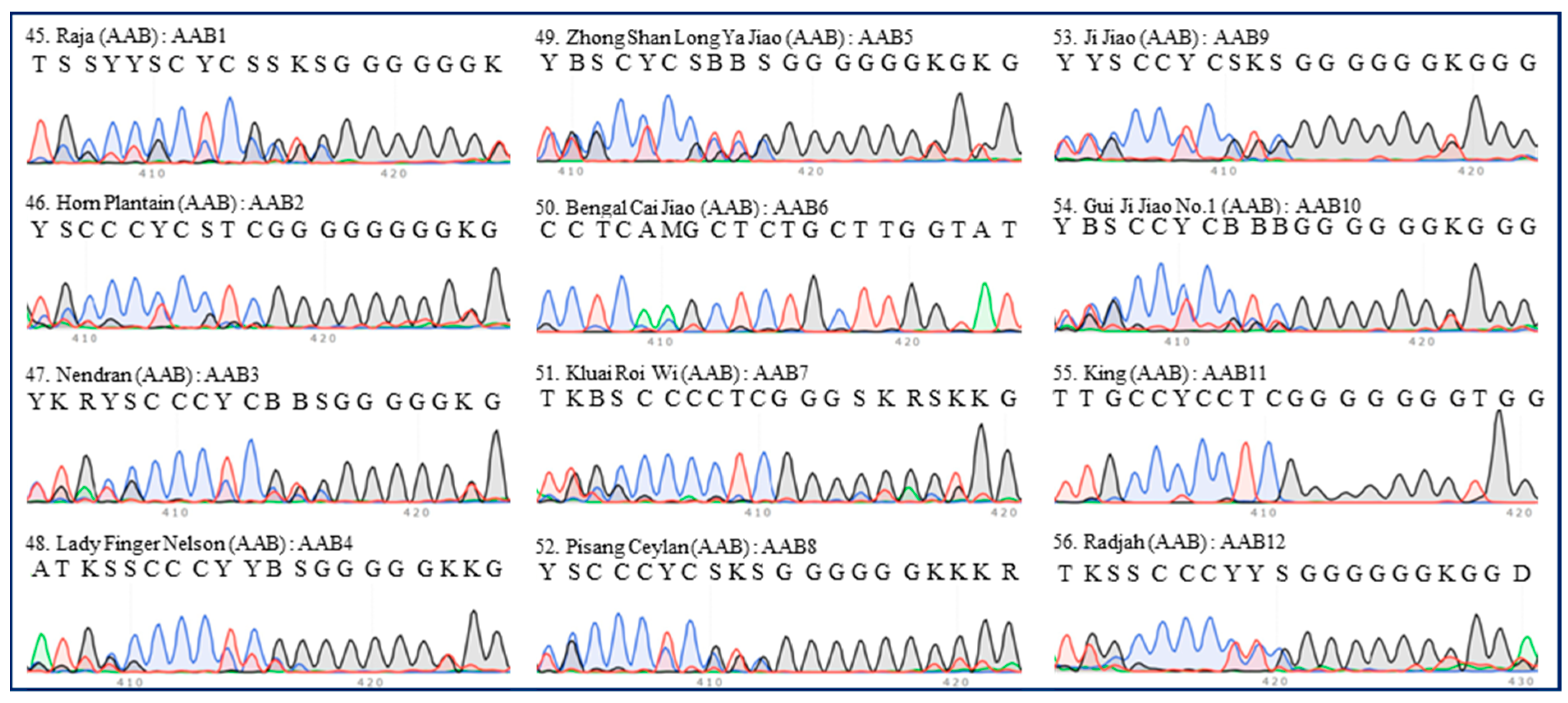
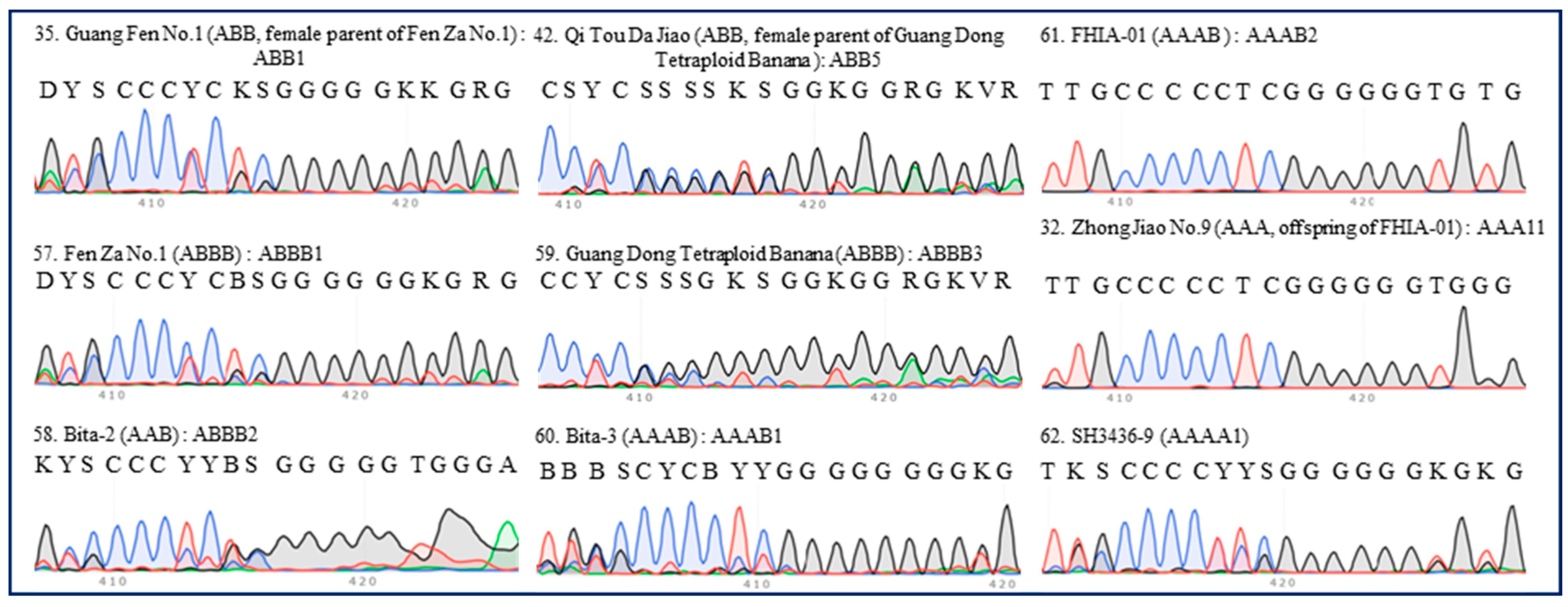
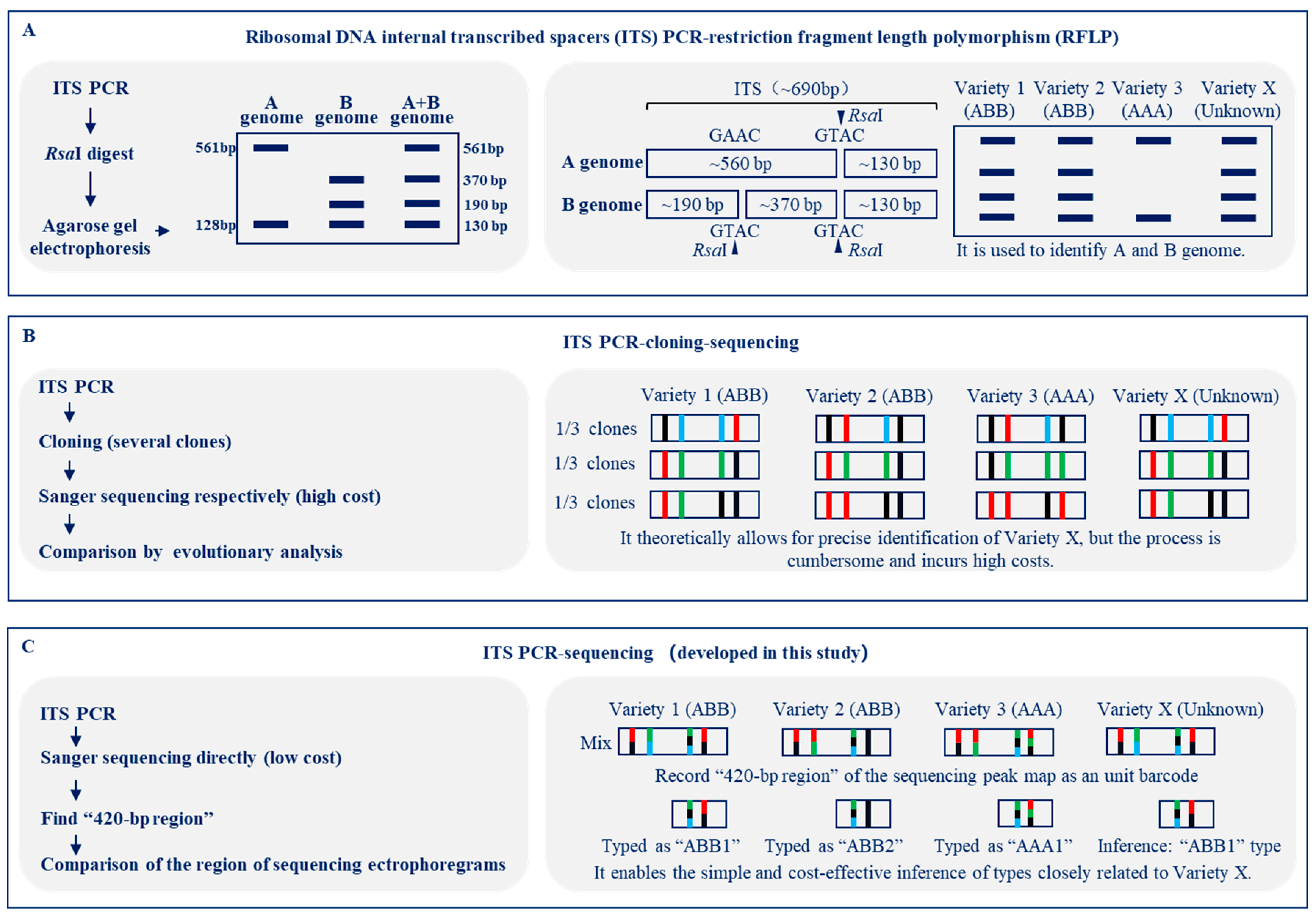
| Serial No. | Name | Accession No. | Group | Subgroup | ITS Type |
|---|---|---|---|---|---|
| 1 | Inarnibal | ITC0477 | AA | Inarnibal | AA1 |
| 2 | Re Gong No.1 | - | AA | Inarnibal | AA1 |
| 3 | Pisang Mas | ITC1403 | AA | Sucrier | AA1 |
| 4 | Pisang Jari Buaya | ITC0312 | AA | Pisang Jari Buaya | AA2 |
| 5 | Jia Li (mutant of Kluai Lep Mu Nang) | - | AA | Unknown | AA3 |
| 6 | Morong Princesa | ITC1150 | AA | Unknown | AA4 |
| 7 | Pamotion | - | AA | Unknown | AA5 |
| 8 | Rose | ITC0712 | AA | Unknown | AA6 |
| 9 | Shou Zhi Jiao | - | AA | Unknown | AA7 |
| 10 | Tudlo Tumbaga | ITC1231 | AA | Unknown | AA8 |
| 11 | Veinte Cohol | ITC1031 | AA | Unknown | AA9 |
| 12 | Ney Pooven | ITC0459 | AB | Ney Pooven | AB1 |
| 13 | Brazil | - | AAA | Cavendish | AAA1 |
| 14 | Costa Rica | - | AAA | Cavendish | AAA2 |
| 15 | Da Feng No.1 | - | AAA | Cavendish | AAA1 |
| 16 | Dwarf Williams | - | AAA | Cavendish | AAA1 |
| 17 | Formosana | ITC1597 | AAA | Cavendish | AAA1 |
| 18 | Nan Tian Huang | - | AAA | Cavendish | AAA1 |
| 19 | Nong Ke No.1 | - | AAA | Cavendish | AAA1 |
| 20 | Pei Chiao | - | AAA | Cavendish | AAA1 |
| 21 | Philippines | - | AAA | Cavendish | AAA1 |
| 22 | Qi Wei | - | AAA | Cavendish | AAA1 |
| 23 | Williams | ITC0570 | AAA | Cavendish | AAA1 |
| 24 | Xian Ba | - | AAA | Cavendish | AAA1 |
| 25 | Green Banana | - | AAA | Red | AAA3 |
| 26 | Gui Hong Jiao No.1 | - | AAA | Red | AAA4 |
| 27 | Hong Jiao Wang | - | AAA | Red | AAA4 |
| 28 | Red Banana | - | AAA | Red | AAA5 |
| 29 | Gros Michel | ITC1122 | AAA | Gros Michel | AAA6 |
| 30 | Berangan | ITC1287 | AAA | Lakatan | AAA7 |
| 31 | Yangambi KM5 | - | AAA | Ibota Bota | AAA8 |
| 32 | Zhong Jiao No.9 | - | AAA | FHIA-01 × SH-3142 | AAA9 |
| 33 | Ai Fen No.1 | - | ABB | Pisang Awak | ABB1 |
| 34 | Bu Si Fen | - | ABB | Pisang Awak | ABB1 |
| 35 | Guang Fen No.1 | - | ABB | Pisang Awak | ABB1 |
| 36 | Jin Fen No.1 | - | ABB | Pisang Awak | ABB1 |
| 37 | Dong Guan Da Jiao | - | ABB | Da Jiao | ABB2 |
| 38 | Gui Da Jiao No.1 | - | ABB | Da Jiao | ABB3 |
| 39 | Hai Nan Niu Ba Jiao | - | ABB | Da Jiao | ABB4 |
| 40 | Lian Shan Ye Sheng Da Jiao | - | ABB | Da Jiao | ABB5 |
| 41 | Pan Yu Da Jiao | - | ABB | Da Jiao | ABB5 |
| 42 | Qi Tou Da Jiao | - | ABB | Da Jiao | ABB5 |
| 43 | Pelipita | ITC0396 | ABB | Pelipita | ABB6 |
| 44 | Saba | ITC1138 | ABB | Saba | ABB7 |
| 45 | Raja | - | AAB | Pisang Raja | AAB1 |
| 46 | Horn Plantain | - | AAB | Plantain | AAB2 |
| 47 | Nendran | - | AAB | Plantain | AAB3 |
| 48 | Lady Finger Nelson | ITC0582 | AAB | Pome | AAB4 |
| 49 | Zhong Shan Long Ya Jiao | - | AAB | Silk | AAB5 |
| 50 | Bengal Cai Jiao | - | AAB | Unknown | AAB6 |
| 51 | Kluai Roi wi | - | AAB | Unknown | AAB7 |
| 52 | Pisang Ceylan | ITC1441 | AAB | Unknown | AAB8 |
| 53 | Ji Jiao | - | AAB | Unknown | AAB9 |
| 54 | Gui Ji Jiao No.1 | - | AAB | Unknown | AAB10 |
| 55 | King | - | AAB | Unknown | AAB11 |
| 56 | Radjah | - | AAB | Unknown | AAB12 |
| 57 | Fen Za No.1 | - | ABBB | Guang Fen No.1 × Musa Balbisiana | ABBB1 |
| 58 | Bita-2 | ITC1296 | ABBB | Fougamou (AAB, Pisang Awak) × Musa Balbisiana 1-63 | ABBB2 |
| 59 | Guang Dong Tetraploid Banana | - | ABBB | Qi Tou Da Jiao×BB | ABBB3 |
| 60 | Bita-3 | ITC1297 | AAAB | Laknau (AAB, Laknau) × Tjau Lagada (AA) | AAAB1 |
| 61 | FHIA-01 | ITC0504 | AAAB | Prata Ana × SH-3142 | AAAB2 |
| 62 | SH3436-9 | ITC1283 | AAAA | Unknown | AAAA1 |
Disclaimer/Publisher’s Note: The statements, opinions and data contained in all publications are solely those of the individual author(s) and contributor(s) and not of MDPI and/or the editor(s). MDPI and/or the editor(s) disclaim responsibility for any injury to people or property resulting from any ideas, methods, instructions or products referred to in the content. |
© 2024 by the authors. Licensee MDPI, Basel, Switzerland. This article is an open access article distributed under the terms and conditions of the Creative Commons Attribution (CC BY) license (https://creativecommons.org/licenses/by/4.0/).
Share and Cite
Zeng, H.; Huang, B.; Xu, L.; Wu, Y. Banana Classification Using Sanger Sequencing of the Ribosomal DNA Internal Transcribed Spacer (ITS) Region. Plants 2024, 13, 2173. https://doi.org/10.3390/plants13162173
Zeng H, Huang B, Xu L, Wu Y. Banana Classification Using Sanger Sequencing of the Ribosomal DNA Internal Transcribed Spacer (ITS) Region. Plants. 2024; 13(16):2173. https://doi.org/10.3390/plants13162173
Chicago/Turabian StyleZeng, Hongyun, Bingzhi Huang, Linbing Xu, and Yuanli Wu. 2024. "Banana Classification Using Sanger Sequencing of the Ribosomal DNA Internal Transcribed Spacer (ITS) Region" Plants 13, no. 16: 2173. https://doi.org/10.3390/plants13162173
APA StyleZeng, H., Huang, B., Xu, L., & Wu, Y. (2024). Banana Classification Using Sanger Sequencing of the Ribosomal DNA Internal Transcribed Spacer (ITS) Region. Plants, 13(16), 2173. https://doi.org/10.3390/plants13162173





